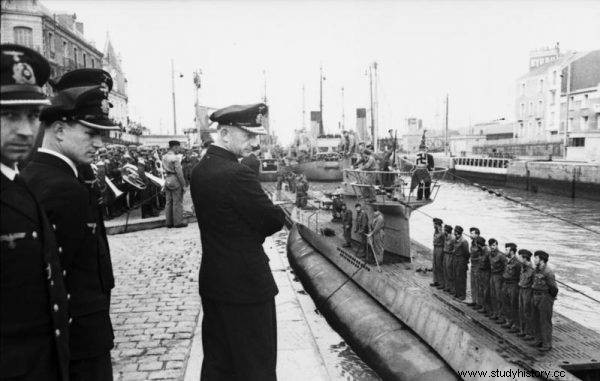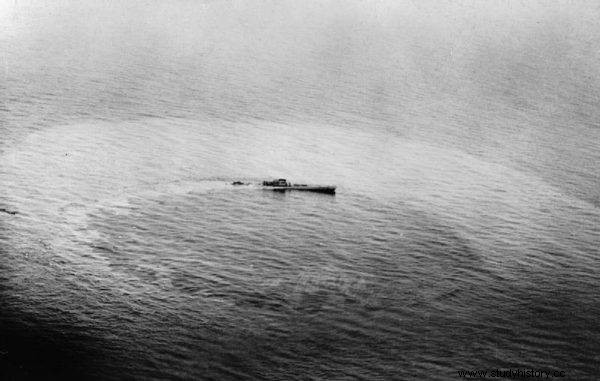German U-boats threatened the English economy. That is why in the Atlantic there was a hunt for "dairy cows", that is, suppliers of fuel and food.
German submarines shook the economy of Great Britain during World War II. Churchill did not hide that the only thing he really got blown about during the war was the threat from the U-boats. That is why there was a great hunt in the Atlantic. "Dairy cows" were hunted (and drowned) - underwater supply carriers filled to the cork with fuel and food in particular.
U-boats were the worst nightmare of the crews sailing on the ships supplying the fighting Great Britain. The seamen on the observation watch had eyes around their heads and hearts in their throats. The night was the most terrible thing. The Germans most often attacked under cover of darkness, firing torpedoes at close range at the sides of ships that were dragging along at a speed of 7 knots. In the central Atlantic, furthest from the coast, an "flight gap" has formed, known as the "U-boat paradise" . Reconnaissance planes did not arrive there, so the Germans could operate there relatively freely.

The most important frontline of World War II
In the first years of the war, when German submarines were "hunters", they sank hundreds of ships carrying supplies for the fighting England in the Atlantic. In London, it was realized that stocks could become so depleted that the population would starve. And that would force the United Kingdom to ask the Germans for peace. As Ballantyne explains, sea deliveries ensured the survival of the Isles' people because:
At the outbreak of the war in September 1939, 55 million tons of foodstuffs and raw materials were imported into the United Kingdom each year. In the summer before the war broke out, Britain consumed 30 percent of the world's wheat production , 25 percent beef and 40 percent tea. (...) Sugar - used with whole tea imported, mainly from Ceylon and India - was imported by the British from 27 countries.

During the first years of the war, when German submarines were "hunters", they sank hundreds of ships carrying supplies for the fighting England in the Atlantic.
For these reasons - according to Churchill - the most important front line of World War II lay in the Atlantic. A bloody battle raged there from the first to the last days of the war. The U-boats hunted the transports and the destroyers hunted the U-boats. On the Allied side, the primary method of detecting the enemy was radio targeting using Huff-Duff receivers. When the ship made a report, its position was localized, similar to the way GPS does today. After locating the signal to the place from which it was sent, ships or planes were sent. Unfortunately, due to the great distances, the search teams most often found only an empty sea surface. Many German commanders realized that their reports could be intercepted, so they quickly changed their place of stay.
Dönitz's "Wolf Packs"
The British did not cope with reading German messages encrypted with the "sea Enigma" for a long time. It had a higher level of complication than those used, for example, by the Wehrmacht or the Luftwaffe. In turn German radio intelligence, B-Dienst, broke the codes of the British navy in 1941. As a result, the U-Bootwaffe command obtained precise data on dates, courses, speed and composition of convoys going to and from England.
The commanding officer of the U-Bootwaffe Admiral Karl Dönitz was thus able to apply the tactic of "wolf packs" already devised during World War I and send U-boats to the middle of the Atlantic to attack the convoy in a group at a convenient time and place. U-boats like wolves "bit" the ships sailing in the convoy with torpedoes. After each attack, there were burning and sinking supply units with tanks, cannons, ammunition and of course ... tea in the rear.
It wasn't until 1943 that the Admiralty concluded that British ciphers were "penetrating". So a new maritime code was introduced and German radio intelligence lost its most valuable source of information. In the middle of this year, the Allies regained the initiative at sea. They went on the offensive - aimed primarily against the U-boats. From "hunters" they have turned into "game". At that time, it was the submarines that were the greatest threat, because the great Kriegsmarine units were already at the bottom (Graff Spee, Blucher, Bismarck) or hiding in ports (Prinz Eugen, Gneisenau, Tirpitz).

Commanding U-Bootwaffe, Admiral Karl Dönitz
In fighting U-boats, the Allies learned to use the most modern achievements of technology. Radar was widely introduced, Huff-Duff receivers were mounted on ships, and the menacing Asdic sonar for detecting submerged ships was perfected. Depth bombs and their launchers were also modernized. However, all these novelties were not always enough. U-boats have repeatedly made brilliant actions, which consisted of swimming between the columns of convoy ships and sending torpedoes once to the left, once to the right . After each such attack, planners in London tearfully searched through ship manifests containing information about the cargo of sunken ships. Churchill grabbed the receiver and called his commanders, demanding: Do something about it!
Hunting for "dairy cows"
In the end they did. First of all, they hit the U-boat logistics system. For some time they had known from the Enigma decryption that "combat" U-boats are supplied at sea by "supply" ships called Milchkühe (milk cow) . These were type XIV large submarines, built from 1941 with the intention of using them as transporters. They were 75 meters long, 9 meters high and had a considerable displacement - 1695 tons. They could stay at sea for up to 10 months. Their crew consisted of as many as 53 sailors, while only 48 people served on ordinary U-boats.
The milk cows did not have torpedo tubes, but did carry four spare torpedoes. They passed them at sea to U-boats that "shot out." They also had fuel for 4-5 U-boats, lubricants, oils, spare parts, ammunition for deck guns, food, medicaments, and mail. Usually, there was also a doctor on board who could perform simple surgical procedures such as putting a broken arm back together or removing a splinter. "Milk Cows" also had a ship's bakery and a workshop that added extra unusual parts. There were only 10 such ships in the Third Reich (construction was planned for 20), while more than 850 were built for "conventional" U-boats. Deficiencies were filled by adapting the XB submarine miners to the role of transporters.

The "combat" U-boats were supplied at sea by "supply" ships called Milchkühe (milk cow).
The role of the "Milchkühe" in maintaining the combat readiness of the U-boats was unquestionable, because the meeting with the "delivery van" in the middle of the Atlantic allowed the ship to regain her combat capability for up to two months. There was also no need to return the U-boat to the port, which took several days. In mid-1943, thanks to the decryption of Enigma, the Royal Navy command was well aware of the role of "milk cows". It was decided to hit them with the help of strong US Navy search groups. A novelty was the use of small escort aircraft against U-boats. Thanks to them the famous "black hole" in the middle of the Atlantic was not so black anymore.
Dangerous maneuvers
Iain Ballantyne in "Killing Crafts" writes:
In July and August 1943, US Navy pursuit and destroyer groups, with a fair share of destroyers, sank 13 U-boats. Among the destroyed submarines were four "milk cows", three of which could also lay mines. (…) The dairy cows had to carry out a time-consuming transfer of supplies on the surface, which inevitably exposed them to enemy attack. The U-Bootwaffe command also had to arrange their meetings with regular U-boats by radio, which resulted in the Allies intercepting and decrypting messages on the subject.
The operation of transferring supplies at sea was very complex. First, the ships had to be connected with fuel lines, fuel delivery took about four hours, and carrying the remaining supplies in pontoons about two hours. It was also extremely complex and dangerous to transfer torpedoes from one ship to another, for which a special pontoon was used, as well as small cranes mounted on the deck.

According to Churchill, the most important front line of World War II was in the Atlantic.
Interestingly, the Germans, famous for their innovative ideas, did not come up with the idea of submerging fuel from ship to ship, although technically it was already possible. And the hunt continued, as demonstrated by the effective action of Avenger and Wildcat aircraft from the escort carrier USS "Card". On October 4, 1943, they surprised the U-460 as they transferred supplies to the U-264, U-455 and U-422 in the middle of the ocean! The Americans sank the "delivery truck" with the Fido acoustic torpedo dropped from the air.
In turn, U-459, U-461, U-462, U-463 were sunk by British planes in the Bay of Biscay as they went out to sea with supplies. Until 1944 only U-488 and U-490 survived, but the first "cow" was hunted on April 26, 1944 by destroyers USS "Barber", USS "Frost", USS "Huse" and USS "Snowden". On June 12, 1944, a radio transmission from the U-490 was tracked, after which the valuable U-boat was captured and sunk by American escort destroyers:USS "Frost", USS "Huse" and USS "Inch".
The Secret of Enigma
“This slaughter of the 'milk cows' dealt a severe blow to Germany's ability to wage long-range warfare. (...) Some combat U-boats had to be assigned to supply tasks so that the submarines on patrols could return to French ports, "writes Iain Ballantyne.
Winston Churchill was very concerned about the confidentiality of his most valuable source of information, the decryption of "Enigma". He had serious concerns about such an unprecedented effectiveness in fighting the "dairy cows", but also about the Allied gaining a visible advantage in the war over the sea .

The slaughter of the "milk cows" dealt a severe blow to Germany's ability to wage war on a long range.
The Germans were sure, however, that Enigma guaranteed communication security, although Dönitz had several times commissioned investigations to determine the source of the leaks. The Germans suspected that the information about the ships going to sea was provided by shipyard workers or the French resistance. Above all, they explained the defeats with the Allied ability to detect radio transmissions. In this particular case, they were right. In his book, Iain Ballantyne assesses:
The war against the U-boats is often presented as having ended with the withdrawal of German submarines from the North Atlantic and the ending of the threat from wolf herds. In fact, it just turned into a different kind of fighting. While during the last large attacks on convoys in April and September 1943, the U-boats fought to ensure Germany's victory in the war , later their goal was to postpone their defeat and discouraging the Allied invasion of southwestern Europe.
It cannot be denied that the latter goal was achieved, albeit at a bloody cost. By the end of the war, German submarines sank 2,800 Allied ships and 175 warships. U-Bootwaffe lost 784 ships out of 830 used in combat.
Bibliography:
- Ballantyne, Deadly craftsmanship. History of the submarine war , Ed. Rebis.
- Blair, Hitler's U-boat war , Ed. Magnum.
- Werner, Iron Coffins , Ed. Finn.
